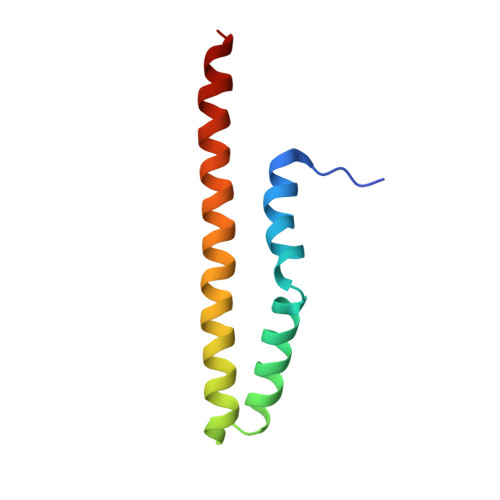A polymorphic helix of a Salmonella needle protein relays signals defining distinct steps in type III secretion.
Guo, E.Z., Desrosiers, D.C., Zalesak, J., Tolchard, J., Berbon, M., Habenstein, B., Marlovits, T., Loquet, A., Galan, J.E.(2019) PLoS Biol 17: e3000351-e3000351
- PubMed: 31260457
- DOI: https://doi.org/10.1371/journal.pbio.3000351
- Primary Citation of Related Structures:
6OFE, 6OFF, 6OFG, 6OFH - PubMed Abstract:
Type III protein-secretion machines are essential for the interactions of many pathogenic or symbiotic bacterial species with their respective eukaryotic hosts. The core component of these machines is the injectisome, a multiprotein complex that mediates the selection of substrates, their passage through the bacterial envelope, and ultimately their delivery into eukaryotic target cells. The injectisome is composed of a large cytoplasmic complex or sorting platform, a multiring base embedded in the bacterial envelope, and a needle-like filament that protrudes several nanometers from the bacterial surface and is capped at its distal end by the tip complex. A characteristic feature of these machines is that their activity is stimulated by contact with target host cells. The sensing of target cells, thought to be mediated by the distal tip of the needle filament, generates an activating signal that must be transduced to the secretion machine by the needle filament. Here, through a multidisciplinary approach, including solid-state NMR (SSNMR) and cryo electron microscopy (cryo-EM) analyses, we have identified critical residues of the needle filament protein of a Salmonella Typhimurium type III secretion system that are involved in the regulation of the activity of the secretion machine. We found that mutations in the needle filament protein result in various specific phenotypes associated with different steps in the type III secretion process. More specifically, these studies reveal an important role for a polymorphic helix of the needle filament protein and the residues that line the lumen of its central channel in the control of type III secretion.
Organizational Affiliation:
Department of Microbial Pathogenesis, Yale University School of Medicine, New Haven, Connecticut, United States of America.














